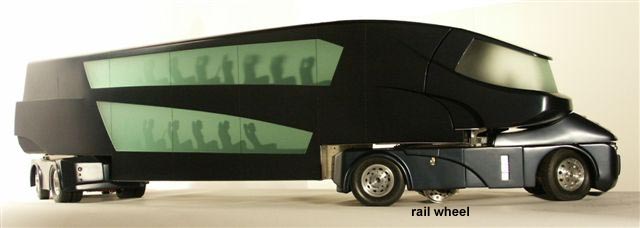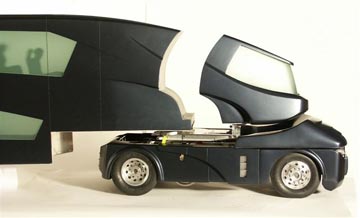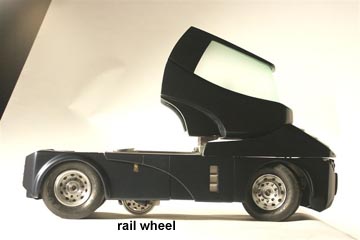Blade Runner Update, July, 2004
Dualmode vehicles, the ultimate in intermodal transport
- Affordable concept allowing transport of freight or passengers on rail as well as road
- Spells rescue for branch lines
- Slashes fuel consumption and emissions
- Brings virtual motorway-standard access to rural areas
- Can expand use of tramways
- Takes out most rail infrastructure cost
- Raises carrying space
Economics of branch lines of the railways could be quickly transformed for the better with a dualmode vehicle being developed by an engineering design company near Darlington Stephenson rail pioneering country.
The innovative vehicle will run on road as well as rail. It is as applicable to freight as to passenger transport. Branch-line infrastructure costs could be at least halved because signalling and points could be largely, if not totally, made redundant.

Leading the project is Carl Henderson, who runs engineering consultancy Silvertip Design in the village of Skeeby, Richmond, North Yorkshire. His dualmode project is being backed by freight trailer and body builder Don Bur, Stoke-on-Trent, and the government's Department of Trade and Industry.
Although its load carrying portion can be either a lorry or a bus the dualmode vehicle resembles a familiar articulated truck up to 16.5 metres long under present regulations. The fundamental departure is that both the powered front section and the bogie of the trailed vehicle have retractable flanged wheels for travelling on railway or tram tracks.
This has been done before but has been heavy, complicated and expensive because of attempts to drive the rail wheels. The Silvertip dual mode does not do this. The driving and braking power comes from the road-mode tyres still contacting the rails.
Weight sharing between rail and road wheels is automatically varied according to the power transmission needs. Only light rubber-tyre contact is needed for normal motion because the rolling resistance on rail is a fifth of that on road much less power needed, so there is also less consumption of fuel.
For acceleration or braking more weight is transferred to the tyres. That speeds scheduling, as less time is spent accelerating from stops. Moreover, regular stopping distance is more than halved because of the enhanced grip. Emergency stopping distance could be cut by about 75 per cent, representing a veritable leap in ability to avoid rail collision.
By being able to change from rail to road transit, the dualmode vehicle can go off rail and steer past another vehicle or obstruction on a tramway. Indeed dualmode is a means of letting a 'tram' drive over to bus stops, enabling freight vehicles a clear tramway. When there is flush hardstanding, a dualmode vehicle can change route at junctions without relying on a railway points system.
Further than that, the dualmode vehicle can deviate from a railway and carry on by road to deliver or collect just like an ordinary bus or lorry. No time need be wasted in transferring goods or people from one mode of transport to another. It is the most versatile interpretation of 'intermodal' yet devised.
The exclusive routeing, speed and fuel economy of rail is combined with the convenience and organisational economy of road. Although the capital cost is understandably greater than that of a pure road vehicle, the overall operating cost is less.
Conservative costing indicates that the yearly depreciation charge would typically be £3,300 more than that of a normal articulated truck but that the savings on running costs would be £7,600. On rail a 45 per cent saving in fuel could be expected.
Railway maintenance costs would be slashed because the ingenious engineering provides a small degree of steering of the rail wheels when going around bends, obviating the alternating stick and slip squeal that causes rail wear. Bends with a radius as tight as eight metres can be tolerated.
Addition of each retractable rail axle adds about half a ton. Another 1.5 tons would be added in the ultimate dualmode vehicle envisaged by Carl Henderson to increase payload volume now often the limiting factor more than payload weight. This is done by mounting the motive unit's cab, not on the chassis directly, but on a turntable frame that pins to the front of the trailer.
That eliminates the gap between tractor and trailerable, for freight, to give more interior load length and provide room for an extra row of pallets. Furthermore, because the rear bogie self steers, it provides more low-level space. Immediately this affords easy step-in access for bus versions while, for freight, there is more than 7 metres between front and rear bogies resulting in 115 cubic metres of total load volume within 4 metres overall height.
The Silvertip dualmode vehicle has reached the working model stage in one-eighth scale. It was displayed by Don Bur at the British commercial-vehicle show that was held at Birmingham's National Exhibition Centre from 23 to 25 March, 2004.
For further information please contact Carl Henderson on TEL +44 (0) 1748 826 060, FAX +44 (0) 1748 826 647
Silvertip Design, Oak Lea, Scurragh Lane, Skeeby, Richmond, North Yorkshire, DL10 5EG,
United Kingdom.


